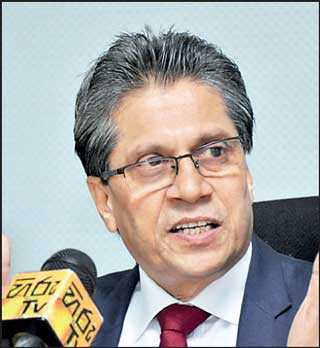Sunday Dec 07, 2025
Sunday Dec 07, 2025
Friday, 15 November 2019 00:00 - - {{hitsCtrl.values.hits}}
By Uditha Jayasinghe
The Board of Investment (BoI) is aiming to end the year with $ 1.5 billion in Foreign Direct Investment (FDI), a top official said yesterday, with plans to tap into the bunkering and petrochemical industry, which could potentially earn Sri Lanka billions in fresh investment over the next five years.
 |
BOI Chairman
|
In 2019, the BOI focused on export catalytic investment, BOI Chairman Mangala Yapa told reporters, insisting that focus was on high local value addition, job creation, and environmental protection. This year Yapa predicted that Sri Lanka had attracted about $ 700 million to $ 800 million and was optimistic of ending the year at $ 1.5 billion. However, this would only be half of the $ 3 billion targeted for 2019.
In 2019, the largest number of 65 projects were from the manufacturing sector, including 24 projects in the apparel sector.
Agriculture attracted five projects, tourism five projects, infrastructure six projects, and knowledge services four projects. The bulk of FDI, however, is expected from two refinery projects, with the second one expected to bring in $ 24 billion over a period of five years.
“Altogether I can say 2019 has not been bad. I cannot say it’s a good year, but it has been promising because despite the constitutional crisis, Easter Sunday attacks, and elections, we have attracted investment. The two refineries make up around $ 27 billion of the investment we have received and they will take about four to five years to implement,” he said.
From 2016 to 2019, the BOI approved 465 projects, with 205 projects or 44% coming from expansions of existing businesses. “There is an investment pipeline so it is not always easy to say where the project is now but I have a complete mapping of the projects, which we constantly monitor. Sometimes the delay is on the part of the investor, sometimes third parties and sometimes the delay can be on the part of BOI and other government partners. The high number of expansions shows the level of confidence existing investors have in the Sri Lankan economy,” Yapa added.
There are also six projects in utilities, which include to two aforementioned petroleum refineries, one of which has already been approved by the government and a second that the BOI signed on Thursday (see box).
Yapa also went onto say that the estimated investment of these projects was $ 36.4 billion with about 94,000 jobs envisaged. This high number is however due to the two refinery projects and without them the amount reduces to $ 8.53 billion.
Agreements of 375 projects have already been signed and these include the two refinery projects. As many as 263 projects have commenced and are at the implementation stage while 138 projects have commenced commercial operations.
“Cumulative FDI flow into the country from 2016 to the third quarter of 2019 is estimated at $ 5.66 billion and makes up 31% of the $ 18.1 billion FDI that has flowed into the country since 1978. The BOI is also in the process of expanding three new export processing zones, effectively doubling the land extend from 3,415 acres to 6,415 acres.”
Of these new export processing zones, Wagawatte has already been dedicated to rubber tires, which spans 150 acres with an envisaged investment potential of $ 350 million to $ 400 million. In Hambantota, a zone spanning 2,200 acres is being set up with an envisaged investment potential of $ 29 billion. In Bingiriya, the export processing zone, which is expected to grow to 1,100 acres in three phases will have an assortment of industries, Yapa said.
“The biggest problem we had was creating new export processing zones because the existing ones were all in the Western Province. The zone in Hambantota is not being created as a dedicated Chinese zone, but Chinese companies can invest. We feel that Hambantota is ideally located to be a petrochemical and bunkering port and that can have a cascading impact. Regulations are changing to push the shipping industry to start using low sulphur fuels and there are few such refineries in this part of the world. Therefore we have an opportunity to provide supplies and our location is also an advantage in this regard.”
He also said that the BOI was considering land in Eravur and Vakarai to establish new investment zones, and there was pressure to move into areas such as Monaragala. Nonetheless, Yapa voiced caution in proceeding, highlighting the need for investment zones to be connected to critical infrastructure such as water, highways, and ports, and outlining the need to make plans including potential investors so that the zones can be used over an extended period of time.
“We need to structure projects that suit these areas, and this is why we are working with industry bodies so they can tell us what their needs are. This also helps to have investments lined up before we establish the zones. We need to cluster industries. When it comes to the refineries we have already done the Environmental Impact Assessment (EIA) for the second refinery but we will also do a health and safety study to ensure minimum hazards. These are long term projects and it is very hard to do things quickly.”
